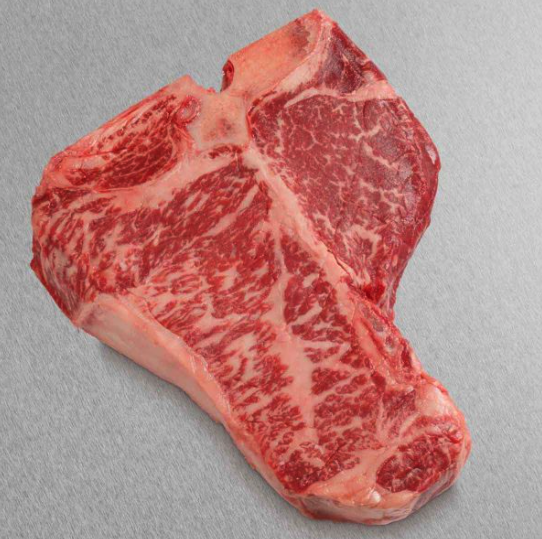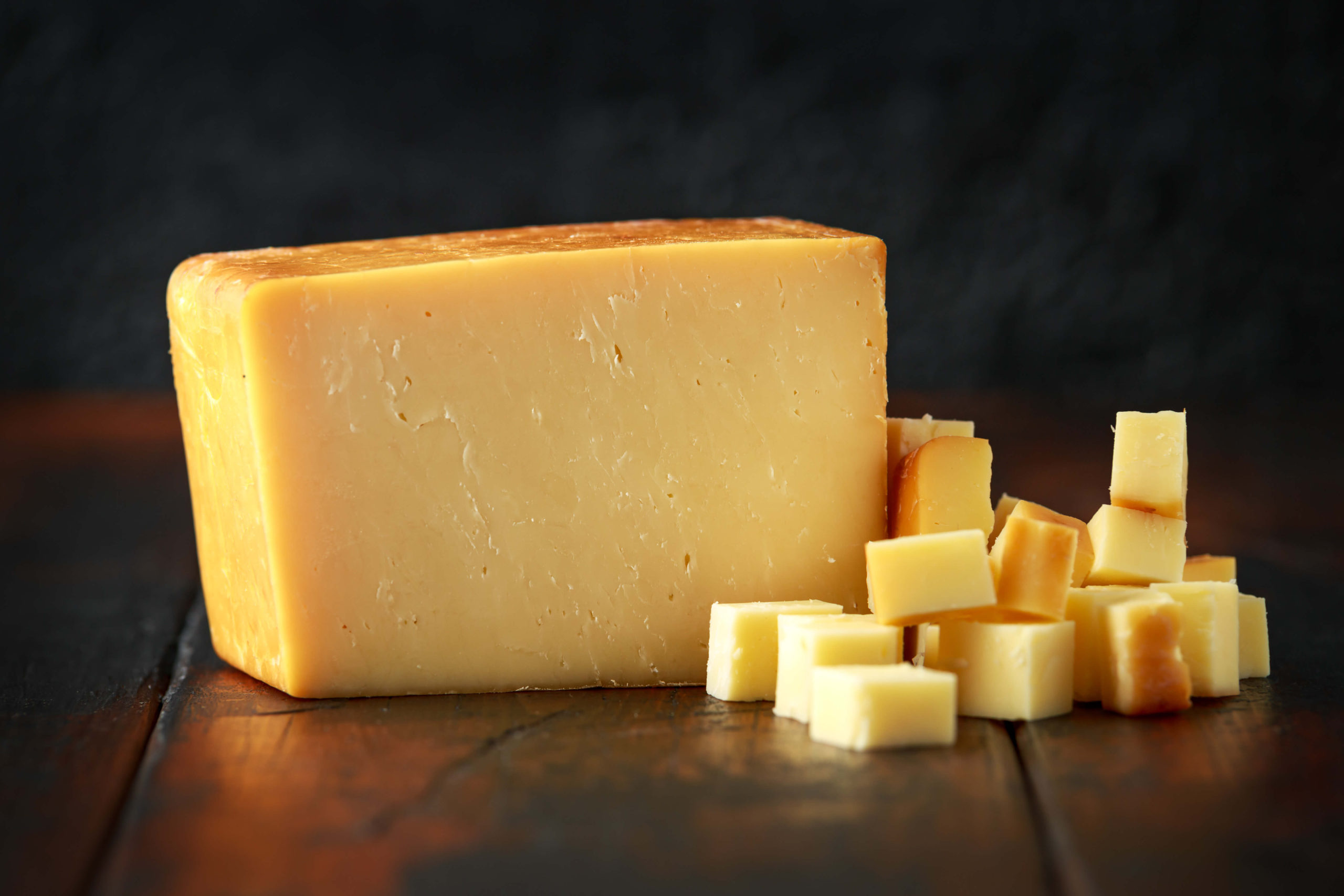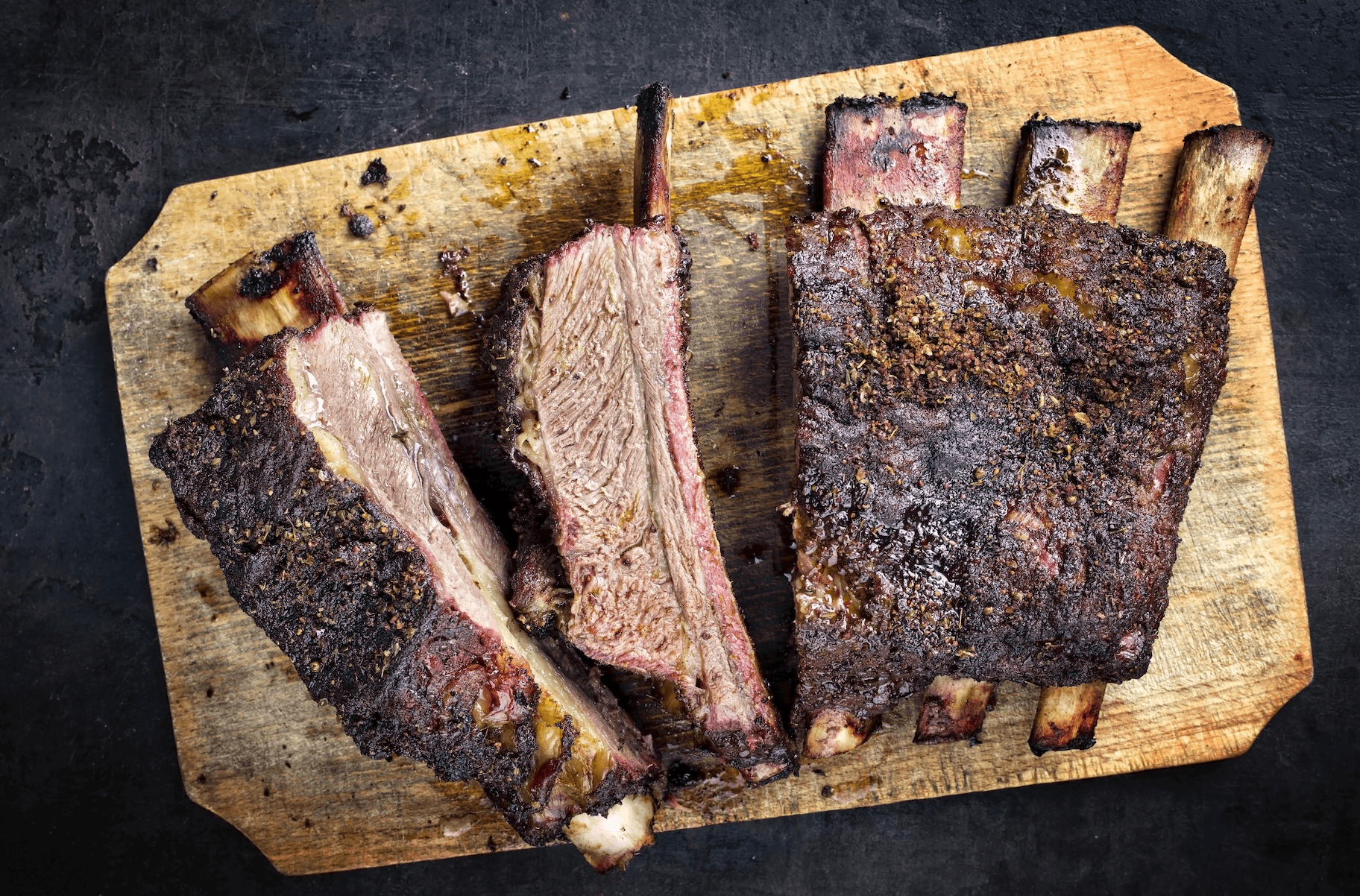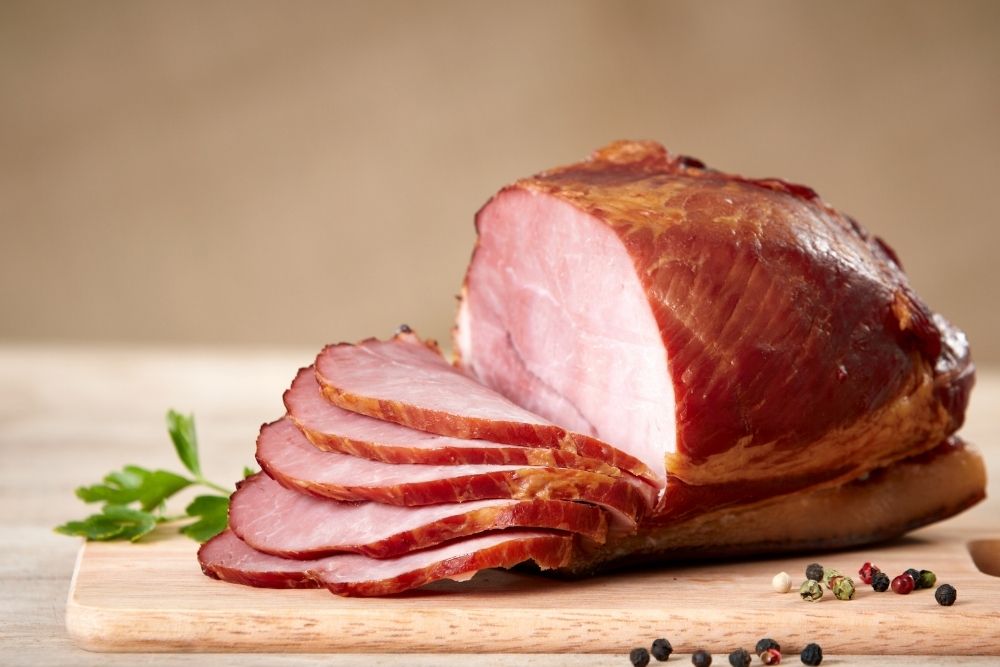When I first started out grilling, I had no idea what the differences were between a T-bone and a Porterhouse steak. And even now that I have some experience, I can certainly appreciate how easy the two tasty steak cuts are to confuse with each other.
After all, both cuts of meat feature a “T” shaped bone – and both are incredibly delicious cuts of meat! And as we’re about to go over, they are extremely similar as well.
In the rest of this post, we’ll go over everything you need to know about the T-Bone vs Porterhouse steak; we’ll touch on similarities, differences, and what to look for when you’re buying each type of steak.
T-Bone vs Porterhouse Steak – Overview
What Are The Similarities?
The T-Bone and Porterhouse steaks are both cut from the short loin and feature a “T” shaped bone in the middle.
Because of this, they can look almost identical – with the difference being that T-Bones are cut from the front of the loin, whereas a Porterhouse is cut more towards the rear and include more tenderloin.
Both steaks have a New York Strip one one side of the bone, and a tenderloin Filet Mignon on the other side.
What’s The Difference?
What technically separates the two classifications of steak is actually the size of the tenderloin section (the side of the bone opposite of the strip steak). According to the U.S. Department of Agriculture, any cut featuring a tenderloin section that’s at least 1.25 inches across at its broadest point is considered a Porterhouse steak.
It’s important to note that the thickness of the steak doesn’t have anything to do with how it’s classified – it’s all about how wide the tenderloin section is.
Any cut with a tenderloin section of 0.51 inches to 1.24 inches is considered a T-Bone steak. And further, anything with a tenderloin section of 0.5 or shorter at its widest point is actually considered a bone-in strip steak.
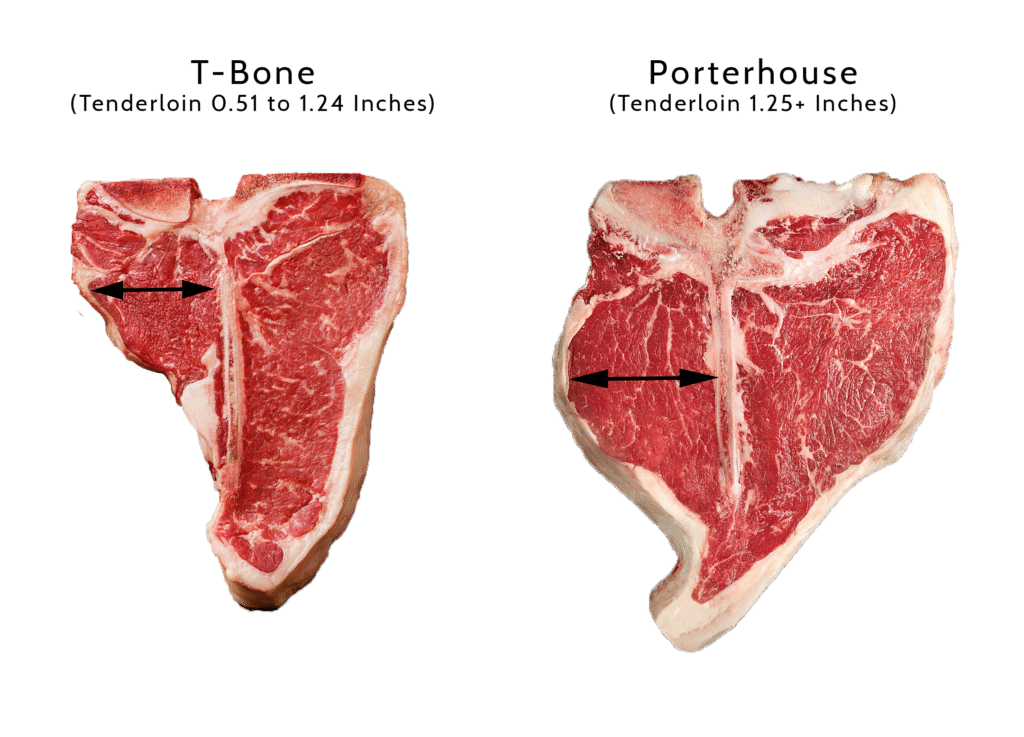
What really gets confusing is that many restaurants and regions of the country will actually refer to a steak that qualifies to be a Porterhouse as a T-Bone steak.
It can be as simple as an inexperienced grocer or butcher, or using the terms interchangeably as slang.
There’s no steak police out there (and it’s not really that HUGE of a deal), so these cuts of meat can get mislabeled somewhat frequently.
T-Bone vs Porterhouse – Price Difference
On a price per pound basis, a Porterhouse will almost cost more than a T-Bone, when comparing similar grades of beef (wagyu, USDA Prime, USDA Choice, etc.).
That’s because the tenderloin part of the steak is one of the most tender and most delicious, it’s quite literally a melt in your mouth filet. So it comes naturally that a Porterhouse would cost more.
Is a T-Bone or a Porterhouse Better?
That part is totally up to you! Personally, one of my favorite things is to grab a Porterhouse steak from my local butcher and fire up the grill when I’m grilling for 2.
It’s a pretty nice experience t0 grill one large piece of meat, then cut it down into both a filet and a New York Strips, then serve one half of each to both people. That way, each person gets some of the flavor packed New York Strip and incredibly tender filet.
When I’m grilling for just myself, I usually lean more towards a “regular” T-bone, if only for the reason that it’s slightly less food and easier to manage for one person! And you still get the full bone in New York Strip with a smaller filet tenderloin piece.
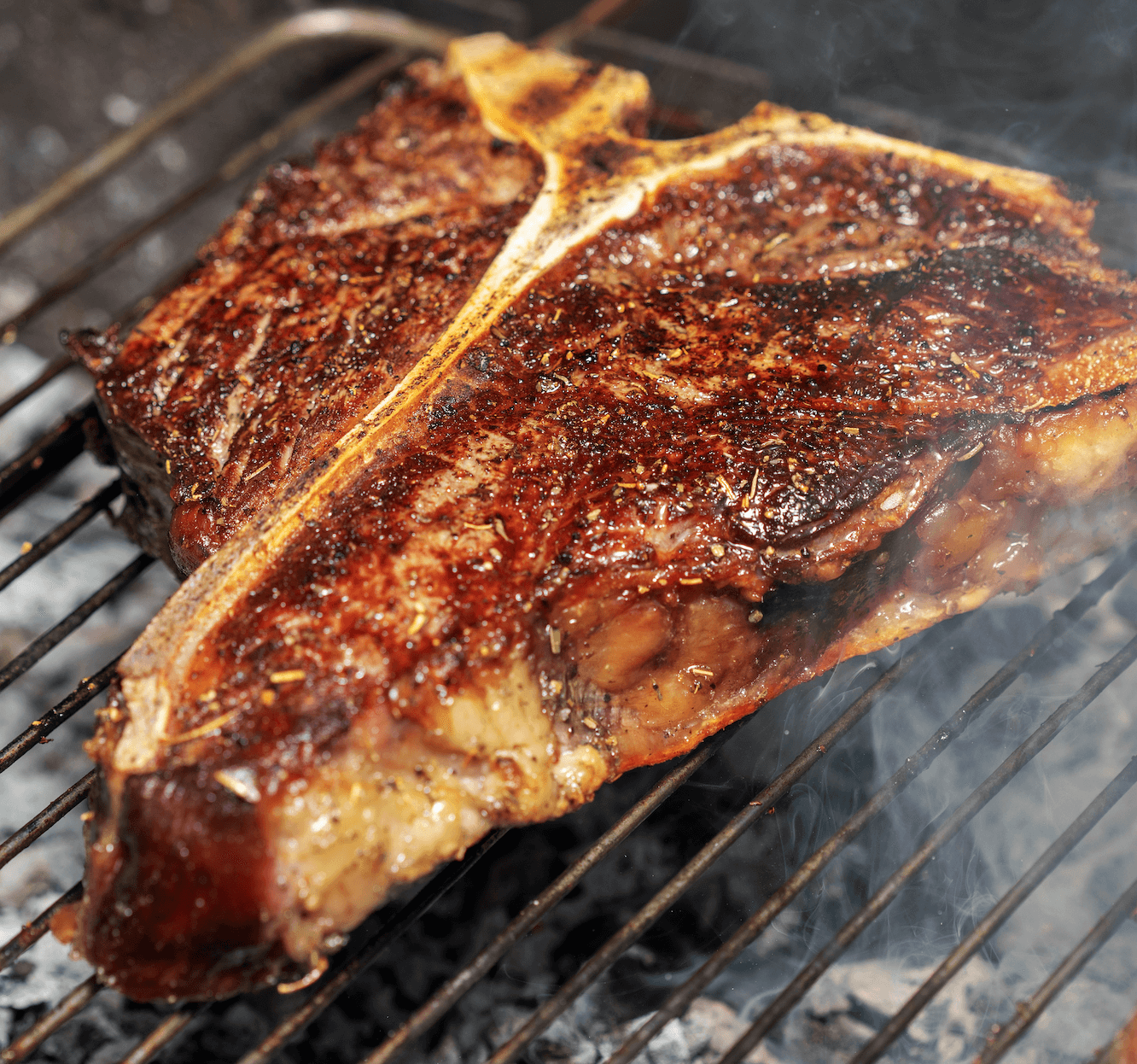
Tips for Buying a Porterhouse Steak
No two cuts of meat are created equal, and the difference between an average and spectacular meal can be decided before you even light up the grill.
It’s super important after you’ve decided which you prefer between T-Bone vs Porterhouse that you know what to look for to buy a quality steak.
Choosing The Best Cut
First, you want to make sure the strip side of the steak has a generous portion, with no significant sections of connective tissue dividing up the steak. Porterhouse steaks that are cut too close to the sirloin section of the cow have a tendency to be infiltrated by tough connective tissue and top sirloin, which is a much heavier used muscle.
Connective tissue, and top sirloin for that matter, are chewy and lacks flavor, and you’ll end up cutting around this part of the steak and paying Porterhouse prices for sirloin quality.
Instead look for a wide, generous portion of strip that has dense white marbling and no connective tissue cross sections.
Last but not least, favor thicker steaks vs thinner ones – the thicker the steak, the easier it is to cook it evenly and retain moisture and tenderness
Important note: A bigger filet does not mean a higher quality filet! It’s more important for the filet to not have connective tissue running through it.
Grilling Tips for Porterhouse and T-Bone
Similar to other cuts of steak, all you really need to season your beef is coarse pepper and salt at a minimum, but feel free to add your other favorite seasonings.
Despite being so close to each other, the strip side and filet side of the steak are actually different enough that you’ll want to place your strip side on a hotter section of the grill, if at all possible. The filet side has less fat and thus will cook faster than the strip side.
Preheat your grill to 450°F. Grill with the strip side of the steak towards the hotter side of the grill, and sear for 4-5 minutes per side, turning the steak 90 degrees halfway through each side for spectacular grill marks.
Make sure to let your steak rest about 10 minutes after pulling it off of the grill to let the juices lock in!
A Note On Other Types of Meat (Non-Beef)
I don’t know about you, but when I hear T-Bone or Porterhouse, I immediately associate those words with beef steaks. While beef is the most common kind of meat for these cuts, you can also find T-Bone or Porterhouse cuts of pork, lamb, and veal.
All of the information above applies no matter which type of animal it came from – the Porterhouse and T-Bone are still highly flavorful and sought after cuts.
Where to Find T-Bone and Porterhouse Steaks Online
Both T-Bone and Porterhouse beef cuts are pretty widely available – odds are you’ll find them in stock at least some of the time at your local grocer or butcher.
But there are also a few online farm to market ranchers that can deliver some incredible steaks straight to your doorstep.
I can personally attest to the quality of Snake River Farms – they’re one of the finest American Wagyu ranches in the USA, and you’ll find their cuts for sale at top notch steakhouses around the country.
They have two cuts for sale that are particularly worth your consideration. They offer a Prime Porterhouse as well as an American Wagyu Porterhouse. Prime is the highest rating the USDA gives for beef cuts, and Waygu is the gold standard when it comes to beef.
Wagyu is naturally a pretty expensive cut, but if you’re splurging for a big meal or just simply a steak enthusiast, the flavor of these cuts are to die for.
The Gold Grade Porterhouse is a superior steak in every sense of the word. It’s cut from out most marbled American Wagyu beef for unparalleled juicy flavor.
Frequently Asked Questions
Is a Porterhouse Steak the Same as a T-Bone Steak?
Contrary to popular belief, a porterhouse steak and a T-bone steak are not the same. There is a lot of confusion around this because as it turns out, both the Porterhouse and T-bone are actually from the same section of the cow.
They both are cut from the short loin. This means that they both have the same pieces of meat – Tenderloin fillet and New York strip (also known as sirloin). This would suggest that they are both the same thing. However, the difference comes when you consider the technical specifications of each piece of meat.
The Department of Agriculture in the US (also known as the USDA) has some strict rules about how much meat is needed on both a Porterhouse and a T-bone in order to be classified as either.
For a Porterhouse steak, it is important that they have more fillet steak on them than T-bone steaks. This fillet needs to be at least 1.25 inches in thickness. If it falls below this then it cannot be given Porterhouse status and is just a T-bone.
With this in mind, you can look at Porterhouse steaks and the bigger version of a T-bone.
What Costs More – T-Bone or Porterhouse?
The Porterhouse steak is typically more expensive than a T-bone steak. The reason for this is because of the volume of meat on the Porterhouse in comparison to the T-bone. This meat is not just any meat, but is the much-desired fillet steak!
The thick fillet steak element of the Porterhouse steak is what gives it its higher cost. That being said, T-bone steaks are also a rather pricey cut of steak compared to some others, and certainly, both a Porterhouse and T-bone will be just as delicious.
It can be difficult to place a price on each of them since the cost will vary based on the size. However, you can expect the Porterhouse steak to cost more per pound than the T-bone steak, purely because of the fact it weighs more and has more fillet steak on it.
What is the Most Tender Steak?
The most tender steak is thought of as being tenderloin. I mean, the name says it all! The reason tenderloin is thought of as being the most tender cut is because of the delicate texture. It is said to ‘cut like butter’, as opposed to some cuts of steak that can be very tough.
This cut of steak is also known simply as ‘fillet steak’, or ‘filet mignon. It is one of the most expensive cuts of steak, as it is so desired and sought after. However, it is worth bearing in mind that in order for it to be as tender as it can be, it needs to be cooked perfectly.
This steak is not without its cons though. Because of the lack of fat running through it, it doesn’t have as much flavor as some other cuts of meat, such as the rib eye.
Why Do They Call It Porterhouse Steak?
The name ‘porterhouse’ is thought to originate from the pubs and inns in England (and in English pubs in other parts of the world) that served the steak. Of course, these steaks are served in other places now, not just pubs, but the name has remained.
These pubs and other establishments often served Porter ale (a very dark and full-bodied ale). Because of this, these pubs became known as porterhouses. As such, the steaks served there became known as porterhouse steaks since that is what they were synonymous with.
Final Thoughts
I hope this post has helped clarify some of the differences with T-Bone vs Porterhouse! If you’re looking for more steak knowledge, head on over to our porterhouse vs ribeye comparison or our NY strip vs ribeye comparison next.
Discover more from Own The Grill
Subscribe to get the latest posts sent to your email.


